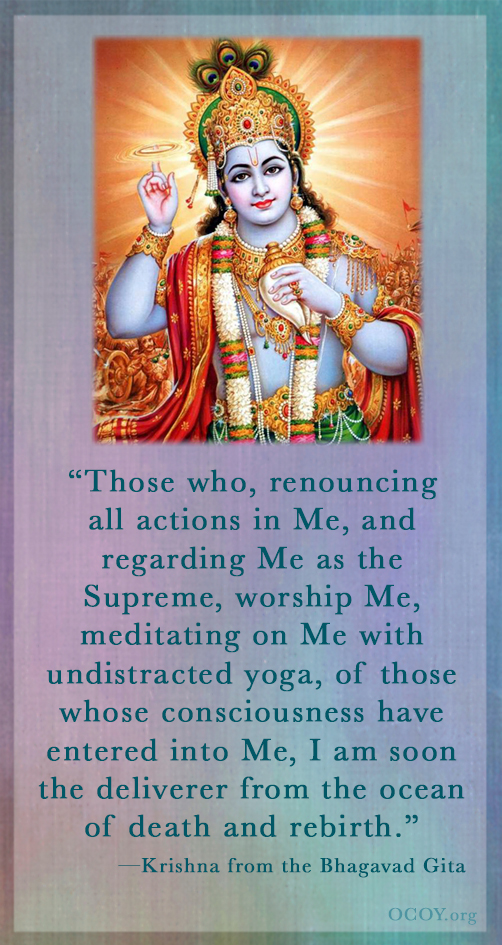A Commentary on the Bhagavad Gita. Part 2 of How Should the Yogi Think of God? [read Part 1 here]
The way of Form (Saguna Brahman)
 Now Krishna expounds the way of those who devote themselves to the attainment of Saguna Brahman.
Now Krishna expounds the way of those who devote themselves to the attainment of Saguna Brahman.
“But those who, renouncing all actions in Me, and regarding Me as the Supreme, worship Me, meditating on Me with undistracted yoga, of those whose consciousness have entered into Me, I am soon the deliverer from the ocean of death and rebirth” (Bhagavad Gita 12:6, 7).
This, too, merits close scrutiny.
Renouncing all actions in Me.
There are a lot of shameless idlers wandering around India pretending to be monks and excusing their indolence and worthlessness as renunciation of action. But Krishna indicates that renunciation must only take place in the state of God-consciousness–that mere abstention from action to supposedly free or purify the mind is meaningless and worthless, a delusion based on ignorance and laziness.
It is utterly mistaken to think that withdrawal from action will free our minds to seek God. That is getting the order completely turned around. First we must establish ourselves in at least a working degree of spiritual awareness before we can think of stopping action.
Sri Ramakrishna said: “There is a kind of renunciation called ‘monkey renunciation.’ A man tormented by the troubles of the world goes to Benares wearing an ocher robe. No news of him for days. Then comes a letter, ‘You should not worry. I have got a job.’”
In the same way when people do not get a job for a long time or feel intimidated by the thought of steady work and financial obligation they begin making noises about taking up monastic life and write to us inquiring as to whether we have room for a hermit in our ashram. In other words, they want to come and idle around in one place with no obligations until they get bored and get the revelation that they can serve God better in the world–as if they would have ever left it!
Regarding Me as the Supreme.
This has two aspects:
- regarding God as the Supreme to such a degree that nothing else occupies our mind or is valued by us, and
- regarding Saguna Brahman as the Absolute–not a lesser or lower aspect of God. For there is only Brahman; the distinction of saguna and nirguna is from our side alone, and is erroneous.
Worship Me, meditating on Me with undistracted yoga.
Unwavering meditation on God is the worship of God. This really should be kept in mind whenever in the Gita we are told to worship God. When Krishna was speaking to Arjuna there was no such thing as a “Hindu temple” in the entire world.
Image worship and temple ritual have all arisen in India after the Christian era, having been absorbed from the Greeks who settled in Kashmir. It is the same with Buddhism. For centuries, until the degeneration of Buddhism, there were no images or temples of Buddha–only dharma halls with a dharma chakra (Wheel of Dharma) on the front wall.
Whose consciousness has entered into Me.
The consciousness must not just be directed to God or concentrated on God–it must enter into God. The yogi’s consciousness must be merged into the Consciousness that is God.
I am soon the deliverer from the ocean of death and rebirth.
No, it will not take dozens of lives. Those who are real yogis will soon arrive at the goal. For them the heaving sea of constant birth and death is no more.
“Keep your mind in Me, your intellect in Me. Thus you shall dwell in Me henceforth. There is no doubt of this” (Bhagavad Gita 12:8).
That is certainly clear. It is a simple matter of cause and effect. Those who keep their minds absorbed in God already begin living in God and shall become perfectly united with God both in this world and in the next.
The alternative
“Or if you are not able to keep your mind steadily on Me, then seek to attain Me by the constant practice of yoga. If you are incapable even of practice, be intent on My work. Even performing actions for My sake, you shall attain perfection. But if you are unable even to do this, then, resorting to devotion to Me, and abandoning all the fruits of action, act with self-restraint. Knowledge is indeed better than practice. Meditation is superior to knowledge. Renunciation of the fruit of action is better than meditation. Peace immediately follows renunciation” (Bhagavad Gita 12:9-12).
This does not mean that yoga is not necessary, but rather that sometimes we have to work backwards. Tyaga, the word translated “renunciation” literally means “abandonment,” and in the Gita means the relinquishment of the fruit of action. Anxiety about results can torment even the yogi, so at the very beginning we must put aside any motives but devotion to God.
Actually, God must be the only aim of our life, not just our formal yoga practice. As the prophet Isaiah said:
“Thou wilt keep him in perfect peace, whose mind is stayed on thee” (Isaiah 26:3).
Further Reading:
- The Bhagavad Gita for Awakening, a Commentary on the Bhagavad Gita
- Chapter One of Abbot George Burke’s new translation of the Gita
- The Bhagavad Gita, arranged for singing, Chapter 1







